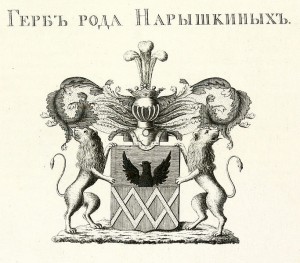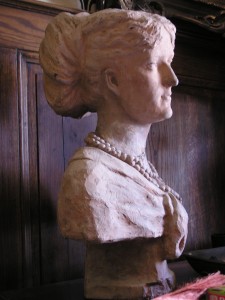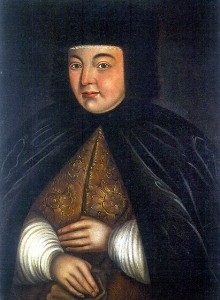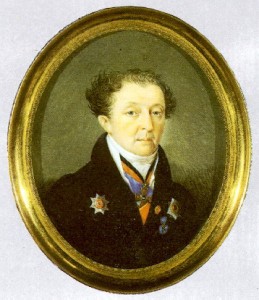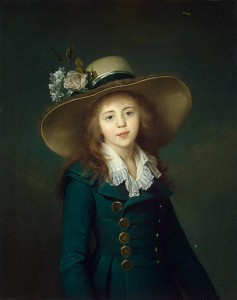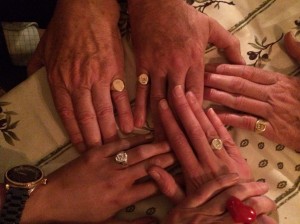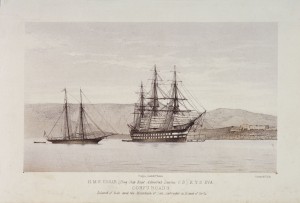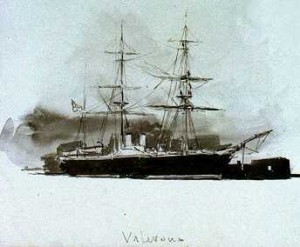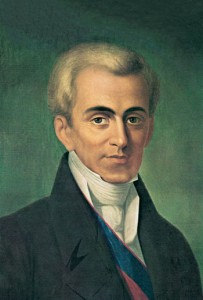At a recent family gathering, it was noticed that five of us were wearing the same signet ring, inherited from our Russian great-great-grandmother or, in one case, great-grandmother. Olga Aleksandrovna Naryshkina (or Narischkine, as it was usually spelt in the West) was born at Paris in 1847, and died at Southsea, Hampshire, in 1927. There was some discussion about what the arms represented. Alternative explanations were offered, but here is mine.
The Naryshkins had been a relatively obscure gentry family until the late seventeenth century, when a certain Natalya Kirilovna Naryshkina had caught the eye of the ‘Most Gentle’ Tsar, Aleksey Mikhailovich. As a child Natalya had been sent to Moscow from the remote province of Torussa, to be brought up there by her godmother, a Scotswoman called Madam Matveeva. This lady, whose maiden name was Hamilton, was married to the Boyar Artemon Matveev, the Tsar’s close friend and adviser. At a time when foreign influences were generally abhorred and when women were shut away from the world in separate quarters, the Matveevs were open to the progressive ideas, habits and customs of the West, which were imbibed by Natalya herself as she grew up. The widowed Aleksey, an occasional visitor to the Matveev house, was charmed by their young ward and, on 22 January 1671, they were married. The following year, Natalya gave birth to a son who was the future Tsar and Emperor Peter the Great.
Natalya’s father and a throng of brothers, uncles and cousins had immediately descended on the court to receive patronage from the uxurious Aleksey. The status of the family was transformed, almost overnight. They were received into the Duma of Boyars and were loaded with lesser titles, as well as gifts of land and serfs. Quick to conceal their undistinguished origins behind a mythical version of their genealogy, they cultivated social pretensions to match. In 1686, when the then joint Tsars, Ivan and Peter, created the famous Velvet Book in which the pedigrees of the nobility were to be inscribed, the Naryshkins entered one that took them back to ancient times. It was claimed that they descended from the Naristi, a Germanic tribe mentioned by Tacitus. As the Naristi were thought to have inhabited the north-west corner of Bohemia, the Naryshkins took as their arms those of the capital of that region, the imperial city of Eger (modern Cheb in the Czech Republic). The arms adopted by the family thus consisted of an imperial eagle with the lower part of its body covered by a grille, alluding to the fact that the incomes of the city had once been placed in pawn by the Emperor. It was further claimed that, as their ancestors had reigned over Eger, the Naryshkins had inherited princely rank, a privilege that in Russia was traditionally reserved for the male-line offspring of former ruling houses (those of Kiev, Lithuania, Tatary and a few others). However, among the Naryshkins, it was a point of honour that the title of prince should never be used. They maintained that their surname was dignity enough.
Tsar Aleksey had died in 1676, to be succeeded by Fedor, the son of his first marriage. After Fedor’s death in 1682, the Naryshkins had hoped to promote Peter to the throne, but had been thwarted by his half-sister Sofya, who, on seizing power, had purged the court of Naryshkin influence, brutally putting leading members of the family to death. Seven years later, they had had their revenge, deposing Sofya in a coup (she was shut away in a convent) and inaugurating the sole reign of Peter, although his mother became the de facto ruler of Russia until her death in 1694. Since that date, the Naryshkin family had never ceased to occupy a position of prominence in the Romanov court.
Given the uncertainties of his early life, it is not surprising that Peter grew up to be remarkably ignorant and uncouth, but it seems he owed all his most remarkable qualities to his mother’s side. The first Romanovs had all been feeble, either in body or mind. Peter was a giant of just under seven feet. When he walked, his officials had to run along beside him in order to keep up. He was naturally athletic, and so dexterous that he could twist a silver platter into a scroll, and cut a piece of cloth with his knife in mid-air. His manners were appalling. On one occasion, when a guest was boring him at dinner, he spat full in his face. The Russian upper classes were not noted in that period for their refinement. Yet it was from Natalya that Peter had inherited the nervous energy which enabled him to modernise and transform his country. His mental agility, his enquiring mind and his admiration for the West were further legacies from his mother. Physically, he is said to have resembled one of her brothers, Fedor Naryshkin.
Olga Naryshkin was descended from one of Natalya’s great-uncles, Ivan Ivanovich. All her ancestors since Ivan had held office at the imperial court. Her great-great-grandfather, Aleksandr Ivanovich (1735 – 82), Chamberlain and Privy Councillor in the reign of Catherine the Great, had married the Princess Anna Nikitishna Trubetskaya, daughter of Prince Nikita Trubetskoy, Procurator-General of the Senate, from the old Lithuanian royal line. Their son, the Senator and Ober-Tseremoniymeister Ivan Aleksandrovich Naryshkin, had in turn married in Catherine’s presence into the fabulously rich Stroganov family, though he had been sentimentally attached to a certain Mademoiselle Vertel, a Frenchwoman who kept a shop in St Petersburg. The Baroness Ekaterina Aleksandrovna Stroganova had nevertheless borne him three sons, Aleksandr, Grigory and Aleksey, and two daughters, Elisaveta and Varvara. Aleksandr was an officer in the Life Guards who had died pointlessly in a duel, having been rash enough to challenge Count Fedor Ivanovich Tolstoy, the most famous duellist of the day. Grigory, the elder surviving son, became a Colonel in the Semenovsky Guards’ Regiment, died in Sorrento in 1835, and was the father of Aleksandr Naryshkin, Olga’s father.
